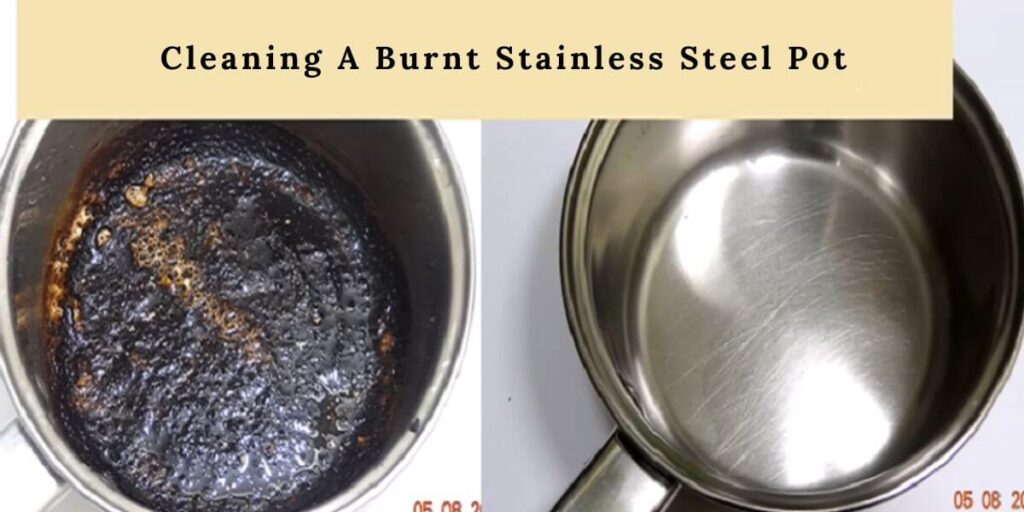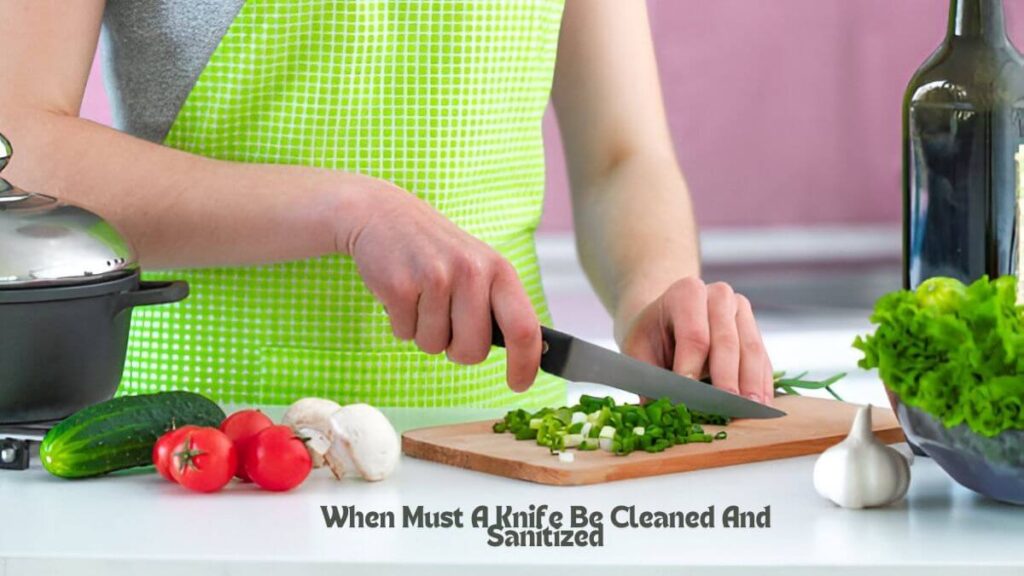How to Clean Burnt Stainless Steel Pot With Baking Soda
Table of Contents
ToggleTo clean a burnt stainless steel pot with baking soda, sprinkle baking soda on the burnt area, add water, and scrub gently.

Burnt stainless steel pots can be a kitchen nightmare. Cleaning them may seem daunting, but baking soda offers a simple solution. Baking soda is a natural abrasive that effectively removes stubborn burnt residues. It’s non-toxic and safe for cookware.
This method requires minimal effort and avoids harsh chemicals. You only need baking soda, water, and a scrubbing tool. This approach is budget-friendly and eco-friendly. Follow these easy steps to restore your pot to its original shine. Whether dealing with minor stains or heavy burns, baking soda can make your stainless steel pot look new again.
Why Stainless Steel Is Ideal For Cooking
Stainless steel offers durability and even heat distribution, making it ideal for cooking. Use baking soda and water to restore the shine of burnt stainless steel pots.
Stainless steel pots are a staple in many kitchens. They are durable, efficient, and perfect for various cooking methods. Understanding why stainless steel is ideal for cooking can help you appreciate your cookware even more.
Durability And Longevity
Stainless steel pots are known for their resilience. Here are some reasons why they last so long:
- Scratch-resistant: Stainless steel doesn’t scratch easily, keeping your pots looking new.
- Rust-resistant: The material resists rust, ensuring longevity.
- Heat-tolerant: It can withstand high temperatures without warping.
Excellent Heat Distribution
Cooking evenly is crucial for delicious meals. Stainless steel cookware excels in this area.
Stainless steel ensures even heat distribution, cooking food uniformly and preventing hot spots. This results in consistently well-cooked dishes, whether simmering a sauce or searing meat.
Non-reactive Surface
Certain metals react with acidic or alkaline foods. Stainless steel avoids this problem, making it ideal for various recipes.
- No flavor alteration: It doesn’t react with ingredients, preserving the dish’s authentic flavor.
- Safe cooking: It prevents harmful chemicals from leaching into your food.
- Versatile use: Suitable for all types of cooking, from making tomato sauce to boiling pasta.
Easy Maintenance
Many people love stainless steel pots because they’re easy to clean and maintain.
Cleaning stainless steel cookware is straightforward. Most pots are dishwasher-safe, and stubborn stains can be removed with simple household items like baking soda. This ease of maintenance ensures that your pots remain in good condition with minimal effort.
Why You Should Cook With Stainless Steel
Cooking with stainless steel ensures durability and even heat distribution. Baking soda easily cleans a burnt stainless steel pot for a sparkling finish and effectively removes stubborn stains without damaging the pot.
Cooking with stainless steel has numerous benefits, making it a favourite in many kitchens. Not only is it durable, but it also enhances the quality of your dishes.
Durability And Longevity
Stainless steel cookware is known for its exceptional durability. It can withstand the rigors of daily cooking without quickly wearing out.
- Resistant to Rust and Corrosion: Stainless steel does not rust or corrode quickly, ensuring long-term use.
- Scratch-Resistant: It can handle metal utensils and abrasive cleaning without scratching.
- Heat-Resistant: Capable of withstanding high cooking temperatures without warping.
Health Benefits
Cooking with stainless steel is a healthier option than using other materials. It doesn’t leach harmful chemicals into your food.
Stainless steel is a non-reactive metal. It doesn’t interact with acidic or alkaline foods, preserving your meals’ flavour and nutritional value.
Easy Maintenance
Maintaining stainless steel cookware is relatively simple. This ease of care makes it a practical choice for busy kitchens.
- Dishwasher Safe: Most stainless steel pots and pans can be cleaned in the dishwasher.
- Stain-Resistant: It doesn’t stain easily, keeping your cookware looking new.
- Simple to Clean: Even burnt-on food can be scrubbed off effortlessly.
Versatility
Stainless steel cookware is incredibly versatile. It can be used for a variety of cooking methods.
- Compatible with All Cooktops: Works on gas, electric, and induction stoves.
- Oven Safe: Many stainless steel pots and pans can go from stovetop to oven.
- Multi-functional: Suitable for boiling, frying, sautéing, and more.
Aesthetically Pleasing
Stainless steel pots and pans add a professional look to your kitchen. Their sleek and shiny appearance is both modern and timeless.
Many chefs and home cooks prefer the polished look of stainless steel. It adds a touch of elegance to any kitchen setup.
Methods For Cleaning A Burnt Stainless Steel Pot
Clean a burnt stainless steel pot by sprinkling baking soda over the burnt area, adding water, and boiling the mixture. Scrub gently with a non-abrasive sponge to remove residue.

Cleaning a burnt stainless steel pot can be daunting, but baking soda makes it more accessible. Discover effective methods to restore your pot’s shine.
Boiling Water And Baking Soda
Start by boiling water in the burnt pot. This will loosen the burnt residue.
- Fill the pot: Add enough water to cover the burnt area.
- Boil the water: Heat until it reaches a rolling boil.
- Add baking soda: Sprinkle a few tablespoons into the boiling water.
- Let it simmer: Reduce heat and let it simmer for 15 minutes.
- Scrub gently: Use a non-abrasive scrubber to clean the softened residue.
Baking Soda Paste
Creating a paste with baking soda can tackle stubborn burns.
Mix baking soda with water to form a thick paste. Apply this paste to the burnt areas and let it sit for 20 minutes. Afterward, scrub gently with a non-abrasive pad. Rinse thoroughly and repeat if necessary.
Vinegar And Baking Soda Reaction
Using vinegar and baking soda together can be very effective.
- Pour vinegar: Add enough to cover the burnt area.
- Heat the pot: Bring the vinegar to a gentle boil.
- Add baking soda: Remove from heat and sprinkle with baking soda.
- Let it fizz: Allow the reaction to work for a few minutes.
- Scrub the pot: Use a soft sponge to remove the burnt residue.
Baking Soda And Aluminum Foil
Aluminum foil can also help clean a burnt pot.
First, sprinkle baking soda over the burnt area. Next, create a ball with a piece of aluminum foil. Use the foil ball to scrub the pot gently. Combining baking soda and aluminum foil helps lift the burnt residue without scratching the pot.
Lemon And Baking Soda
Combining lemon with baking soda adds extra cleaning power.
- Cut a lemon: Slice it in half.
- Sprinkle baking soda: Apply it to the burnt area.
- Use lemon: Scrub with the lemon half.
- Rinse and repeat: Wash the pot and repeat if needed.
Using these methods, you can effectively clean your burnt stainless steel pot and restore its shine.
Why Burnt Food Sticks To Stainless Steel
Burnt food sticks to stainless steel because the high heat causes food residues to bond with the metal surface. To clean a burnt stainless steel pot, use baking soda to create a paste, scrubbing gently and rinsing thoroughly. This method effectively removes stubborn burnt-on food without damaging the pot.

Cleaning a burnt stainless steel pot can be daunting, especially when food residue clings stubbornly to the surface. Understanding why food sticks can help you tackle the problem more effectively.
The Nature Of Stainless Steel
Stainless steel is a popular choice for cookware due to its durability and resistance to rust. Despite these benefits, specific characteristics make it prone to food sticking:
- Lack of Non-Stick Coating: Stainless steel lacks a non-stick surface, making it easier for food to adhere.
- Heat Distribution: Uneven heat distribution can cause hotspots, leading to burnt food.
The Role Of Temperature
Temperature plays a crucial role in why food sticks to stainless steel. Here are some key points to consider:
- High Heat: Cooking on high heat without enough oil can cause food to burn quickly.
- Sudden Temperature Changes: Placing a hot pot in cold water can cause food to stick more firmly.
Chemical Reactions
Chemical reactions between food and stainless steel are another reason for sticking. Here’s why:
- Protein Binding: Proteins in food, like meat, bond with the steel surface.
- Caramelization: Sugars in food caramelize and form a sticky residue.
Importance Of Oil
Using oil correctly can prevent food from sticking. Understanding its role can be helpful:
- Lubrication: Oil forms a barrier between the food and the pot.
- Heat Conductor: Oil helps even with heat distribution, reducing hotspots.
Food Moisture Content
Moisture content in food also affects how it interacts with stainless steel:
- Low Moisture: Foods with low moisture, like rice, are more prone to sticking.
- High Moisture: Foods with high moisture, like vegetables, are less likely to stick.
Understanding these factors can help you avoid burnt food and make cleaning easier.
Preventing Future Burns On Stainless Steel Cookware
Clean burnt stainless steel pots effortlessly with baking soda. Sprinkle generously, add water, and let it sit. Gently scrub to reveal a spotless surface.

Nothing is more frustrating than dealing with a burnt stainless steel pot. Luckily, preventing future burns is easier than you think. Follow these tips to keep your cookware in top condition and enjoy hassle-free cooking.
Use Proper Heat Levels
Always match the heat level to your cooking method. High heat isn’t necessary for most dishes and can lead to burns.
Preheat The Cookware
Preheating your pot can make a big difference. It helps distribute the heat evenly, which can prevent burning.
- Preheat on medium heat: This ensures that the pot heats evenly.
- Add oil or butter: Once the pot is preheated, add your cooking fat to create a non-stick layer.
Stir Frequently
Stirring your food often can help prevent it from sticking and burning.
Regular stirring is crucial for maintaining even cooking. It distributes heat more uniformly and prevents food from sticking to the bottom.
Use Adequate Oil Or Butter
Using enough oil or butter is essential. It creates a barrier between the food and the pot, reducing the risk of burning.
- Choose the right oil: Opt for oils with high smoke points, like canola or avocado oil.
- Don’t skimp on quantity: Ensure the pot’s surface is well-coated to prevent sticking.
Avoid Empty Pot Heating
Never heat an empty stainless steel pot. This can cause discoloration and increase the risk of burning food.
Always make sure there’s something in the pot. Whether it’s water, oil, or food, this will help maintain a stable temperature.
Clean Thoroughly After Each Use
A clean pot performs better and reduces the chance of burns. Residue from previous cooking sessions can cause uneven heating.
- Use mild detergents: Harsh chemicals can damage the stainless steel.
- Dry completely: Moisture can lead to rust, affecting the pot’s performance.
Following these steps, you can keep your stainless steel cookware in excellent condition and avoid those annoying burns. Happy cooking!
Tips For Preventing Burnt Stainless Steel Pots
Easily clean burnt stainless steel pots by sprinkling baking soda over the burnt area. Add hot water, let it sit, then scrub gently. Repeat if necessary for a sparkling clean pot.
Burning a stainless steel pot can be frustrating. Thankfully, there are ways to prevent this. Here are some practical tips to keep your stainless steel pots pristine.
Use Low To Medium Heat
Cooking with high heat often causes food to stick and burn. Keep your heat settings in check to avoid this:
- Low to medium heat: Helps distribute heat evenly.
- Avoid high heat: Prevents food from sticking and burning.
Preheat Your Pot Properly
Proper preheating ensures even cooking and prevents sticking. Here’s how to do it right:
- Place your pot on the stove. Set it to medium heat.
- Wait a few minutes: The pot should warm evenly before adding oil or food.
Add Oil Or Butter After Preheating
Adding oil or butter after preheating creates a non-stick surface. Here’s why:
- Forms a protective layer: Prevents food from sticking.
- Enhances flavor: Adds a delicious touch to your dishes.
Stir Food Regularly
Constant stirring ensures food cooks evenly. It also prevents burning:
- Stir frequently: Helps distribute heat.
- Use appropriate utensils: Choose wooden or silicone for better results.
Avoid Overcrowding The Pot
Overcrowding can cause uneven cooking and burning. Here’s how to avoid it:
- Cook in batches: Ensures even heat distribution.
- Give food space: Helps cook more evenly.
Use A Timer
Timing is crucial for preventing burnt pots. Set a timer to keep track:
- Monitor cooking times: Prevents overcooking.
- Stay alert: This helps you avoid distractions while cooking.
Following these tips can save your stainless steel pots from burns and keep them looking brand new. Happy cooking!

Additional Green Cleaning Tips For Your Kitchen
Easily clean a burnt stainless steel pot using baking soda. Sprinkle baking soda over the burnt area, add water, and let it sit before scrubbing. This eco-friendly method restores shine without harsh chemicals.
A sparkling kitchen is a joy to work in; green cleaning methods can improve it. Explore some additional eco-friendly cleaning tips to keep your kitchen spotless and safe.
Use Vinegar For Countertops
Vinegar works wonders on countertops:
- Natural disinfectant: Kills germs and bacteria without harsh chemicals.
- Removes stains: Effectively cleans coffee and food stains.
- Deodorises: Eliminates lingering odours from cooking.
Lemon For Microwave Cleaning
Lemon can be your best friend for cleaning the microwave:
- Fresh scent: Leaves a pleasant citrus smell.
- Loosens grime: Makes it more accessible to wipe away food splatters.
- Natural cleaner: Safe to use around food.
Olive Oil For Stainless Steel
Stainless steel shines with a bit of olive oil:
- Removes fingerprints: Wipes away smudges and prints.
- Adds shine: Leaves surfaces gleaming.
- Eco-friendly: Non-toxic and safe for kitchen use.
Salt For Scrubbing
Salt can be a powerful scrubber for stubborn spots:
- Non-abrasive: Safe for various surfaces.
- Effective cleaner: Works well on cutting boards and pans.
- Natural and safe: No harmful residues left behind.
Baking Soda For Odor Removal
Baking soda is excellent for keeping your kitchen fresh:
- Absorbs odors: Neutralizes smells in the fridge and trash can.
- Gentle cleaner: Safe for pots, pans, and sinks.
- Multi-purpose: Can be used in many different areas.
Essential Oils For Freshness
Essential oils add a pleasant scent to your kitchen
- Aromatic: Leaves a long-lasting fragrance.
- Disinfecting properties: Many oils have natural antibacterial qualities.
- Versatile: Can be used in sprays, diffusers, and cleaners.
Cornstarch For Window Cleaning
Cornstarch can make your windows sparkle:
- Streak-free: Ensures a clear, spotless finish.
- Gentle on glass: Won’t scratch or damage surfaces.
- Easy to use: Mix with water for a simple cleaning solution.
Tea Tree Oil For Mold Prevention
Prevent mold with tea tree oil:
- Natural antifungal: Keeps mold and mildew at bay.
- Safe and non-toxic: Ideal for use in the kitchen.
- Simple application: Mix with water and spray on problem areas.
Hydrogen Peroxide For Cutting Boards
Hydrogen peroxide ensures clean cutting boards:
- Disinfectant: Kills bacteria and viruses.
- Removes stains: Lightens and cleans surfaces.
- Easy to find: Available at most stores.
Club Soda For Grease
Club soda tackles grease effectively:
- Cuts through grease: Breaks down oily residues.
- Easy to use: Pour and wipe away.
- Safe for all surfaces: Won’t harm kitchen counters or appliances.
Using these green cleaning tips, you can maintain a pristine kitchen while being kind to the environment. Happy cleaning!
Frequently Asked Questions
Conclusion
Cleaning a burnt stainless steel pot with baking soda is simple and effective. This method saves time and restores your cookware. Remember to scrub gently to avoid scratches. Keep your pots looking new by using this natural solution regularly. Enjoy the gleaming results and happy cooking!
Related Posts
-
 26 Nov 2024 CleaningHow to Clean Stainless Steel Countertops | Experts Tips
26 Nov 2024 CleaningHow to Clean Stainless Steel Countertops | Experts Tips -
 17 Nov 2024 Cleaning5 Tricks | How to Clean Shower Head Without Vinegar
17 Nov 2024 Cleaning5 Tricks | How to Clean Shower Head Without Vinegar -
 14 Nov 2024 CleaningHow to Keep Damascus Steel from Rusting: Essential Care Tips
14 Nov 2024 CleaningHow to Keep Damascus Steel from Rusting: Essential Care Tips -
 13 Nov 2024 CleaningHow to Clean a Folding Knife Properly: Essential Tips and Tricks
13 Nov 2024 CleaningHow to Clean a Folding Knife Properly: Essential Tips and Tricks -
 13 Nov 2024 CleaningHow to Clean a Ninja Blender Quick Tips & Tricks for a Deep Clean
13 Nov 2024 CleaningHow to Clean a Ninja Blender Quick Tips & Tricks for a Deep Clean -
 12 Nov 2024 CleaningHow to Clean Rust off of a Knife: Tips for Long-Lasting Blade Care
12 Nov 2024 CleaningHow to Clean Rust off of a Knife: Tips for Long-Lasting Blade Care -
 23 Oct 2024 CleaningHow to Clean Grout That Has Turned Black: Expert Tips & Tricks
23 Oct 2024 CleaningHow to Clean Grout That Has Turned Black: Expert Tips & Tricks -
 19 Oct 2024 CleaningHow to Clean Blackstone Griddle: Quick & Easy Tips
19 Oct 2024 CleaningHow to Clean Blackstone Griddle: Quick & Easy Tips -
 19 Oct 2024 CleaningHow to Clean Burnt Stainless Steel Pot With Baking Soda
19 Oct 2024 CleaningHow to Clean Burnt Stainless Steel Pot With Baking Soda -
 15 Oct 2024 CleaningWhen Must A Knife Be Cleaned And Sanitized? Natural solution
15 Oct 2024 CleaningWhen Must A Knife Be Cleaned And Sanitized? Natural solution













